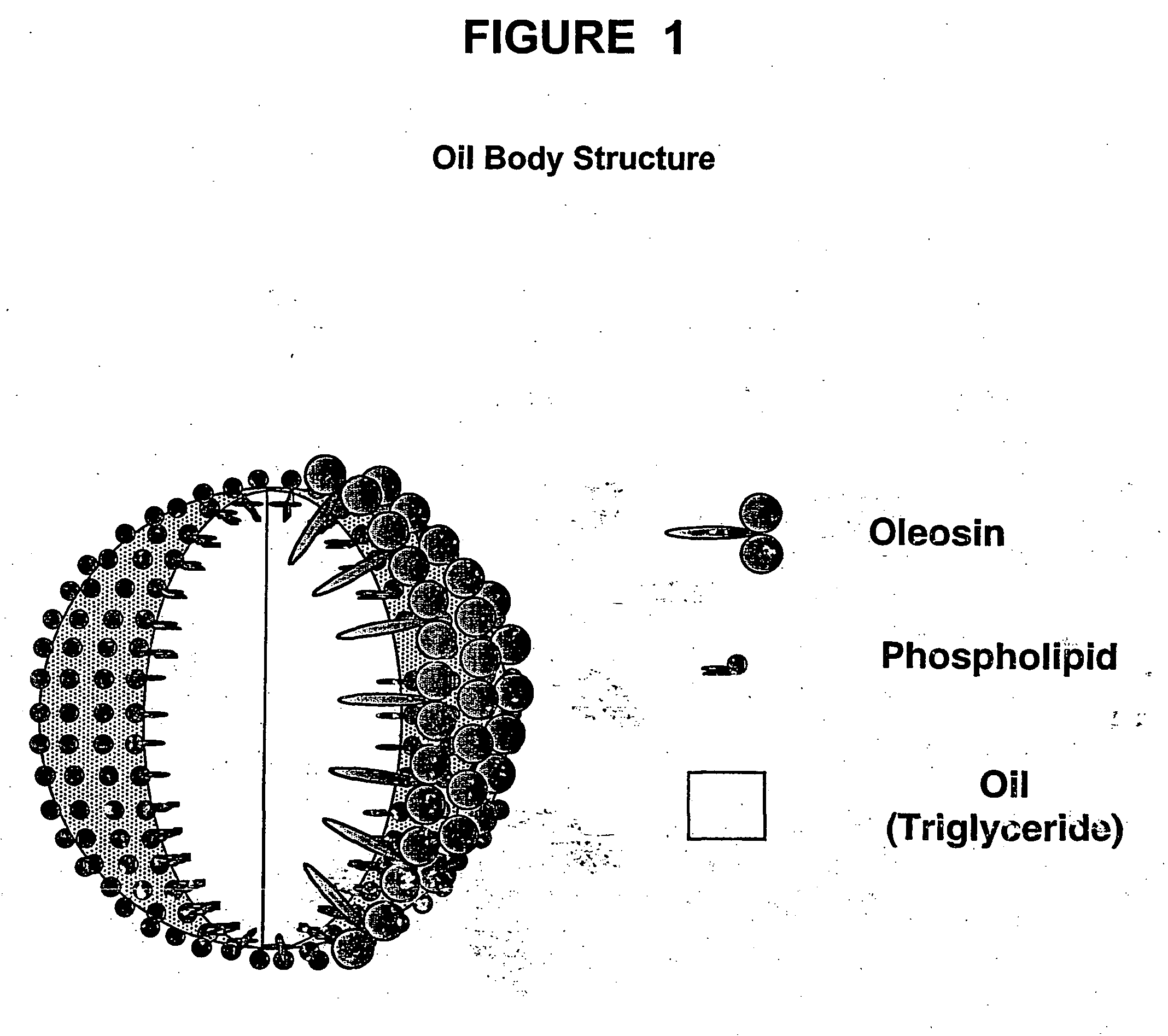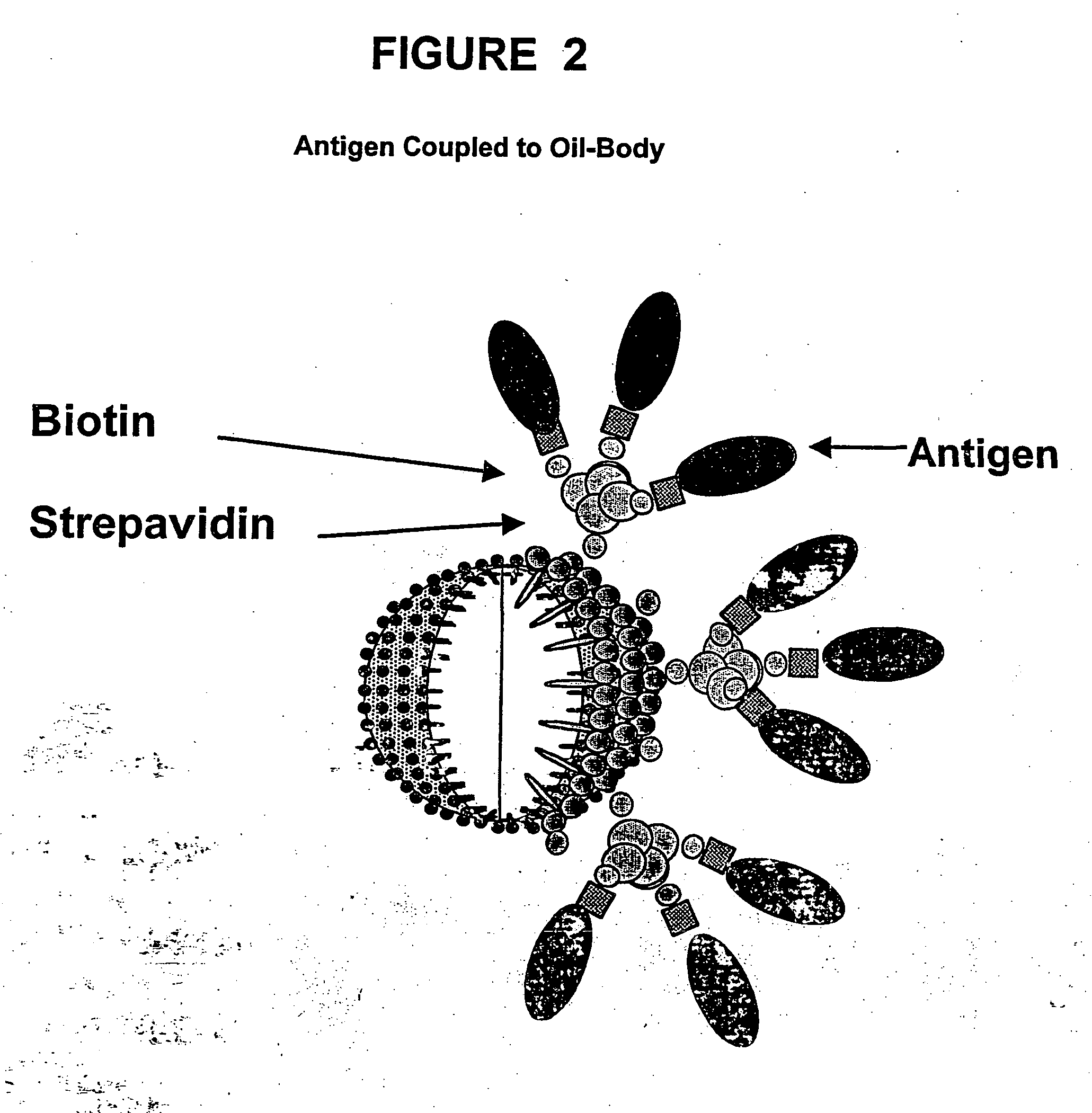Use of plant oil-bodies in vaccine delivery systems
a technology of plant oil and vaccine delivery system, which is applied in the direction of antibody medical ingredients, peptide sources, immunological disorders, etc., can solve the problems of difficult to define a precise mode of action, prolonged stimulation of the immune system for protracted periods, and neither is acceptable for human clinical use, so as to enhance the immune response to the antigen
- Summary
- Abstract
- Description
- Claims
- Application Information
AI Technical Summary
Benefits of technology
Problems solved by technology
Method used
Image
Examples
example 1
Modification of Native Oil-Bodies for Binding Antigens
[0314] In this example, the, use of native oil-bodies derived from non-transgenic plants for antigen delivery is described. The isolated native oil-bodies were chemically modified to contain biotin molecules covalently linked to oil body proteins such as oleosins. These modified oil bodies are able to bind antigen-antigen complexes, thus providing a vaccine composition containing oil bodies, antigen and a streptavidin-coupling moiety. To carry out the chemical modification of oil bodies, plant seeds from the oilseed plant Brassica napus were used for the isolation of oil-bodies. All procedures were performed under sterile conditions. Typically, 2-3 grams of mature seeds were first surface sterilized by treatment with 70% ethanol for 15 min at room temperature. The seeds were washed 2 to 3 times with sterile saline, then crushed in a pre-sterilized mortar with pestle using enough sterile saline to maintain liquid consistency. The...
example 2
Production of Recombinant Antigens
[0315] A novel expression system for production of recombinant antigen was employed to produce antigen that is easily purified and contains a single biotin moiety at a selected region. The expression vector can be induced to express in E. coli and contains a T7 promoter and a region encoding an N-terminal biotin consensus sequence (Schatz, P. J. 1993. Use of peptide libraries to map the substrate specificity of a peptide-modifying enzyme: A 13 residue consensus peptide specifies biotinylation in Escherichia coli. Bio / Technology 11:1138-1143), a polyhistidine segment and a multiple cloning site (MCS) to facilitate fusion in frame to foreign genes. The vector is referred to as pT7biohistag. The restriction map of this vector is shown in FIG. 5. Expression in E. coli from this vector containing a coding sequence inserted in-frame into the MCS results in a recombinant fusion protein that can readily be purified by metal-chelate chromatography due to th...
example 3
Coupling of Oil Bodies and antigens
[0316] In this example, biotinylated oil-bodies and biotinylated antigens were combined in the presence of streptavidin to form an oil-body-antigen complex. One mole of streptavidin can bind four moles of biotin, thus streptavidin can be used to link or couple the biotinylated antigen to the biotinylated oil-bodies. In order to couple the biotinylated antigen to the biotinylated oil-bodies, the biotinylated antigen was premixed with streptavidin and this mixture was then added to the biotinylated oil bodies. This stepwise coupling allows control of the amount of antigen that is coupled to the oil-body surface. As a control, adding a large excess of free biotin allows for the isolation of biotinylated oil-bodies without antigen attached. All preparations of antigen, streptavidin and oil-bodies were made in sterile saline. Non-particulate preparations were filter sterilized. Biotinylated antigen was combined with streptavidin (SA) at 2.5:1 molar rat...
PUM
| Property | Measurement | Unit |
|---|---|---|
| Density | aaaaa | aaaaa |
| Density | aaaaa | aaaaa |
| Density | aaaaa | aaaaa |
Abstract
Description
Claims
Application Information
 Login to View More
Login to View More - R&D
- Intellectual Property
- Life Sciences
- Materials
- Tech Scout
- Unparalleled Data Quality
- Higher Quality Content
- 60% Fewer Hallucinations
Browse by: Latest US Patents, China's latest patents, Technical Efficacy Thesaurus, Application Domain, Technology Topic, Popular Technical Reports.
© 2025 PatSnap. All rights reserved.Legal|Privacy policy|Modern Slavery Act Transparency Statement|Sitemap|About US| Contact US: help@patsnap.com



